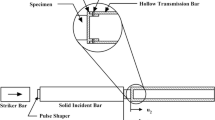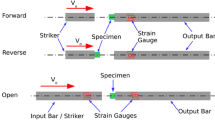Abstract
An experimental technique that modifies the conventional split Hopkinson pressure bar has been developed for measuring the compressive stress-strain responses of materials with low mechanical impedance and low compressive strengths such as elastomers at high strain rates. A high-strength aluminum alloy was used for the bar materials instead of steel, and the transmission bar was hollow. The lower Young's modulus of the aluminum alloy and the smaller cross-sectional area of the hollow bar increased the amplitude of the transmitted strain signal by an order of magnitude as compared to a conventional steel bar. In addition, a pulse shaper lengthened the rise time of the incident pulse to ensure stress equilibrium and homogeneous deformation in the low-impedance specimen. Experimental results show that the high strain rate, compressive stress-strain behavior of an elastomeric material can be determined accurately and reliably using this technique.
Similar content being viewed by others
References
Kolsky, H., “An Investigation of Mechanical Properties of Materials at Very High Rates of Loading,”Proc. Phys. Soc. Lon., B,62,676–700 (1949).
Follansbee, P.S., “The Hopkinson Bar,”Mechanical Testing, Metals Handbook, 9th ed.,8,American Society for Metals,Metals Park, OH,198–217 (1985).
Ross, C.A., Jerome, D.M., Tedesco, J.W., andHughes, M.L., “Moisture and Strain Rate Effects on Concrete Strength,”ACI Mat. J.,93,293–300 (1996).
Chen, W. andRavichandran, G., “Dynamic Compressive Failure of a Glass Ceramic Under Lateral Confinement,”J. Mech. Phys. Solids,45,1303–1328 (1997).
Gamby, D. andChaoufi, J., “Asymptotic Analysis of Wave Propagation in a Finite Viscoplastic Bar,”Acta Mechanica,87,163–178 (1991).
Wang, L., Labibes, K., Azari, Z., andPluvinage, G., “Generalization of Split Hopkinson Bar Technique to Use Viscoelastic Bars,”Int. J. Impact Eng.,15,669–686 (1994).
Bragov, A.M. andLomunov, A.K., “Methodological Aspects of Studying Dynamic Material Properties Using the Kolsky Method,”Int. J. Impact Eng.,16,321–330 (1995).
Zhao, H., Gary, G., andKlepaczko, J.R., “On the Use of a Viscoelastic Split Hopkinson Pressure Bar,”Int. J. Impact Eng.,19,319–330 (1997).
Knauss, W.G., Boyce, M., McKenna, G., andWineman, A., “Nonlinear, Time-dependent Constitution of Engineering Polymers,”Report No. 95-10, Institute for Mechanics and Materials, University of California, San Diego, 1–16 (1995).
Chen, W., Subhash, G., andRavichandran, G., “Evaluation of Ceramic Specimen Geometries Used in Split Hopkinson Pressure Bar,”DYMAT J.,1,193–210 (1994).
Ravichandran, G. andSubhash, G., “Critical Appraisal of Limiting Strain Rates for Compression Testing of Ceramics in a Split Hopkinson Pressure Bar,”J. Am. Ceramic Soc.,77,263–267 (1994).
Geers, T.L., “Analysis of Wave Propagation in Elastic Cylindrical Shells by the Perturbation Method,”J. Appl. Mech.,39,385–389 (1972).
Duffy, J., Campbell, J.D., andHawley, R.H., “On the Use of Torsional Hopkinson Bar to Study Rate Effects in 1100-0 Aluminum,”J. Appl. Mech.,38,83–91 (1971).
Togami, T.C., Baker, W.E., andForrestal, M.J., “A Split Hopkinson Bar Technique to Evaluate the Performance of Accelerometers,”Trans. ASME, J. Appl. Mech.,63,353–356 (1996).
Dioh, N.N., Leevers, P.S., andWilliams, J.G., “Thickness Effects in Split Hopkinson Pressure Bar Tests,”Polymer,34,4230–4234 (1993).
Gray, G.T. III, Blumenthal, W.R., Trujillo, C.P., andCarpenter, R.W. II, “Influence of Temperature and Strain Rate on the Mechanical Behavior of Adiprene L-100,”J. Phys. IV France Colloq. C3 (DYMAT 97),7,523–528 (1997).
Author information
Authors and Affiliations
Rights and permissions
About this article
Cite this article
Chen, W., Zhang, B. & Forrestal, M.J. A split Hopkinson bar technique for low-impedance materials. Experimental Mechanics 39, 81–85 (1999). https://doi.org/10.1007/BF02331109
Received:
Revised:
Issue Date:
DOI: https://doi.org/10.1007/BF02331109




